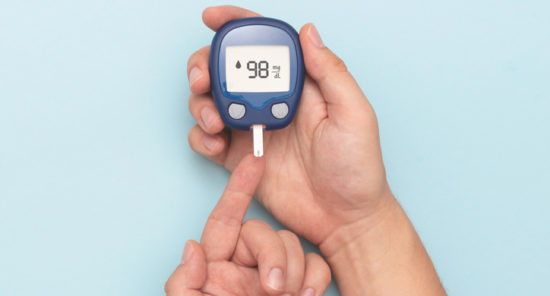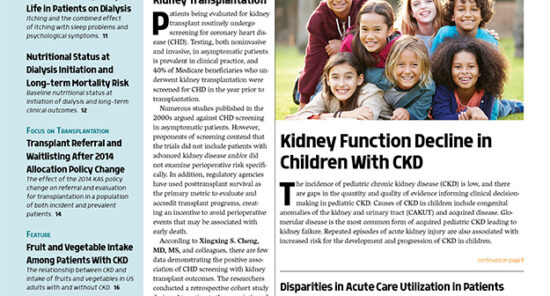Credit: Original article published here.By 2040, chronic kidney disease (CKD) is projected to be one of the top four leading causes of potential years of life lost. CKD is associated with various comorbidities and complications, including secondary hyperparathyroidism (SHPT) and vitamin D insufficiency (VDI). As patients experience decline in kidney function, there are significant alterations in the metabolism of calcium, phosphorus, and vitamin D that cause increased production and secretion of parathyroid hormone (PTH). The combination of decreased kidney function, mineral abnormalities, and high rates of comorbidities are associated with reduced quality of life for many patients. SHPT develops as a result of abnormalities in these parameters. Low levels of serum total 25-hydroxyvitamin D (25D) and 1,25-dihydroxyvitamin D play a major role in the progression of SHPT. Concurrent diagnoses of CKD and SHPT have been linked to increased risk of progression of kidney disease, cardiovascular disease, and mortality. Patients with CKD and SHPT have significantly higher medical costs and use of health care resources compared with patients with CKD alone. Poor vitamin D status and elevated levels of PTH commonly occur in patients with stage 3 to 5 CKD, and can emerge as early as stage 2. Early and sustained
Credit: Original article published here.Patients with glomerular disease may experience acute medical complications such as anasarca, infections, acute kidney injury, thromboembolism, and cardiovascualr events that require utilization of acute care (emergency department [ED] visit or hospitalization). In addition, patients with glomerular disease being treated with immunosuppressive therapies commonly experience infections that can result in utilization of acute care. According to Jill R. Krissberg, MD, MS, and colleagues, the risk of utilization of acute care may be affected by race, ethnicity, and socioeconomic status (SES). The researchers conducted a prospective cohort study designed to compare rates of acute care utilization across racial and ethnic groups in adults and children with glomerular disease in the CureGN (Cure Glomerulonephropathy) cohort. They sought to test the hypothesis that rates of acute care utilization would be increased among Black or Hispanic patients but that lower SES and more severe glomerular disease in those groups would explain any observed differences. Results of the study were reported in the American Journal of Kidney Diseases [2023;81(3):318-328]. The study cohort included 1456 adults and 768 children with biopsy-proven glomerular disease enrolled in the CureGN cohort. The study exposure was race and ethnicity as a participant-reported social factor. Race and
Credit: Original article published here.Sodium-glucose transport protein 2 (SGLT2) inhibitors (SGLT2i), or gliflozins, block SGLT2 cotransporters in the proximal tubules and reduce renal glucose and sodium reabsorption.1 Reduced reabsorption of sodium results in natriuresis, which, through tubuloglomerular feedback, causes a reduction of intraglomerular pressure. SGLT2i have been shown to not only slow kidney progression in patients with chronic kidney disease regardless of diabetes status, but also improve glucose control, reduce the risk of heart failure, and reduce blood pressure, and they do so in a cost-effective manner.2 The use of SGLT2i has been limited despite approval in the United States since 2013 (canagliflozin). One important factor, which research suggests might be a myth, is that underutilization of SGLT2i therapy is due to their high cost or high copayments. Two recent studies have reported on utilization of SGLT2i where cost was not a factor, namely the US Department of Veterans Affairs (VA), where prescriptions are free. The first study by Mahtta et al looked at SGLT2i use in 537,980 patients with atherosclerotic cardiovascular disease (ASCVD) and type 2 diabetes mellitus (T2DM) in 130 VA facilities.3 They reported that approximately 11% of patients were on SGLT2i therapy. Surprisingly, among individuals with an
Credit: Original article published here.There is an association between type 2 diabetes and a higher risk of developing kidney failure. Helena Bleken Østergaard, MD, and colleagues conducted a study designed to develop and validate a decision support tool to aid in estimating the 10-year and lifetime risks among individuals with type 2 diabetes of developing kidney failure. The researchers also sought to examine individual treatment effects of preventive medication in that patient population. Results were reported in the Clinical Journal of the American Society of Nephrology [2022;17(12):1783-1791]. The researchers utilized data from the Swedish National Diabetes Register for 2002-2019 on 707,077 individuals with prevalent and incident type 2 diabetes to develop the prediction algorithm. Kidney failure was defined as the first occurrence of kidney transplantation, long-term dialysis, or persistent estimated glomerular filtration rate <15 mL/min/1.73 m2. Using routinely available predictors, two Cox proportional regression functions for kidney failure and all-cause mortality as respective end points were developed. The functions were combined into life tables to calculate the predicted survival without kidney failure while using all-cause mortality as the competing outcome. A cohort of 256,265 individuals with incident type 2 diabetes from the Scottish Care Information Database between 2004 and 2019
Credit: Original article published here.Management of patients with anemia of chronic kidney disease (CKD) seeks to reduce red blood cell transfusions and avoid complications such as allosensitization. Researchers, led by Vivekanand Jha, MBBS, MD, DM, PhD, conducted an analysis of data on red blood cell transfusion needs in patients with CKD on and not on dialysis in the ASCEND-D and ASCEND-ND trials. Trial participants were treated with daprodustat, a novel hypoxia inducible factor prolyl hydroxylase inhibitor, or with erythropoiesis-stimulating agents (ESAs). Results were reported during a poster session at the National Kidney Foundation Spring Clinical Meetings 2023. The poster was titled The Effects of Daprodustat on Blood Transfusion Rates in the ASCEND-D and -ND Trials. The analysis included data on rates of red blood cell transfusions (events per 100 patient-years) in the ASCEND-D and ASCEND-ND trials and in the ASCEND-D ESA hyporesponder (ESA-HR) subgroup (baseline ESA-resistance index >2.0/>450 U/kg epoetin per week). In prespecified analyses, adjustments in Cox proportional model-estimated hazard ratios (HR) included treatment/region, dialysis type in ASCEND-D participants, and randomization-ESA use in ASCEND-ND trial participants. In both trials, red blood cell transfusions (≥5%) and overall red blood cell transfusion rates were numerically lower in patients in the daprodustat
Credit: Original article published here.According to Jake Hunnicutt, PhD, and colleagues, there are few data on the use of red blood cell transfusion among patients with anemia and nondialysis dependent chronic kidney disease (CKD) in the United States. Data on how the rates of red blood cell transfusion vary by hemoglobin level are also limited. During a poster session at the National Kidney Foundation Spring Clinical Meetings 2023, the researchers presented data on the rate of red blood cell transfusions and associated complications from 2017 to 2019. The poster was titled Red Blood Cell (RBC) Transfusion Use Varies by Baseline Hemoglobin (Hb) and Is Associated With Posttransfusion Hyperkalemia and Hospitalization Within 30 Days in US Patients With Stage 3-5 CKD and Anemia. The retrospective cohort study utilized Optum’s deidentified Integrated Claims-Clinical dataset. Inclusion criteria were hemoglobin measure (index date), prior evidence of stage 3-5 CKD, and anemia (defined as treatment for anemia or baseline hemoglobin <12 g/dL for women or <13 g/dL for men). Analyses were stratified by insurance type (commercial or Medicare Advantage [MA]). Associations between baseline hemoglobin and red blood cell transfusion events within 6 months were quantified using estimated adjusted rate ratios (aRR) and 95% CIs. Claims
Credit: Original article published here.There are limited treatment options to reduce persistent cardiovascular and renal risk in patients with type 2 diabetes and stage 4 chronic kidney disease (CKD). Results of FIDELITY, a prespecified pooled analysis of FIDELIO-DKD (Finerenone in Reducing Kidney Failure and Disease Progression in Diabetic Kidney Disease) and FIGARO-DKD (Finerenone in Reducing Cardiovascular Mortality and Morbidity in Diabetic Kidney Disease) demonstrated that heart-kidney outcomes were improved in participants with CKD and type 2 diabetes who were treated with finerenone. Pantelis Sarafidis, MD, and colleagues conducted a FIDELITY subgroup analysis to examine the effects of finerenone among participants with stage 4 CKD (defined as estimated glomerular filtration rate [eGFR] <30 mL/min/1.73 m2). Efficacy outcomes of interest were a cardiovascular composite (cardiovascular death, nonfatal myocardial infarction, nonfatal stroke, or hospitalization for heart failure) and a kidney composite (kidney failure, sustained ≥57% decrease in eGFR from baseline, or kidney disease death). Results were reported online in the Clinical Journal of the American Society of Nephrology [doi:10.2215/CJN.0000000000000149]. FIDELITY included 13,023 participants. Of those, 7% (n=890) had stage 4 CKD. The hazard ratio for risk of the cardiovascular composite outcome with finerenone versus placebo among participants with stage 4 CKD was 0.78
Credit: Original article published here.Kidney stone disease has an estimated prevalence of 8%-9%, and is associated with substantial rates of recurrence. While not completely understood, both genetic and environmental factors are known to be associated with the formation of kidney stones. Major international guidelines on the diagnostic workup and clinical management of patients with kidney stones emphasize the use of metabolic evaluation, including 24-hour urine collection to determine parameters that include volume, pH, calcium, oxalate, citrate, uric acid, potassium and magnesium. However, according to Pietro Manuel Ferraro, MD, MSc, PhD, and colleagues, there are conflicting data regarding actual implementation of 24-hour urine collections. In addition to imprecision and incompleteness, collecting urine throughout the day is perceived as being impractical and difficult to perform in clinical practice. The researchers conducted an analysis to assess the performance of spot urine measurement to estimate 24-hour excretion in patients with kidney stones. Results of the analysis were reported in Nephrology Dialysis Transplantation [2022;37(11):2171-2179]. The study recruited 74 adult patients ≥18 years of age with urinary stone disease from two centers (BioHealth Italia, Torino, Italy, [n=54] and Tufts University School of Medicine, Maine Medical Center, Portland, Maine, USA, [n=20]) from October 2013 to September 2014.
Credit: Original article published here.Patients being evaluated for kidney transplant routinely undergo screening for coronary heart disease (CHD). Testing, both noninvasive and invasive, in asymptomatic patients is prevalent in clinical practice, and 40% of Medicare beneficiaries who underwent kidney transplantation were screened for CHD in the year prior to transplantation. Numerous studies published in the 2000s argued against CHD screening in asymptomatic patients. However, proponents of screening contend that the trials did not include patients with advanced kidney disease and/or did not examine perioperative risk specifically. In addition, regulatory agencies have used posttransplant survival as the primary metric to evaluate and accredit transplant programs, creating an incentive to avoid perioperative events that may be associated with early death. According to Xingxing S. Cheng, MD, MS, and colleagues, there are few data demonstrating the positive association of CHD screening with kidney transplant outcomes. The researchers conducted a retrospective cohort study designed to estimate the association of pretransplant CHD testing with rates of death and myocardial infarction (MI). Results were reported online in JAMA Internal Medicine [doi:10.1001/jamainternmed.2022.6069]. The study included all adult, first-time kidney transplant recipients from January 2000 through December 2014 in the US Renal Data System. Eligible patients had at
Credit: Original article published here.DocWire News recently spoke with Allen Davidoff, Ph.D., the CEO of XORTX Therapeutics (pronounced Zor-tex). XORTX is developing novel therapies for progressive kidney disease. The company is planning to launch a Phase 3 study for its lead candidate, oxypurinol, in patients with the rare disease Autosomal Dominant Polycystic Kidney Disease (ADPKD), with plans to expand to diabetic nephropathy (kidney failure in diabetes patients) and more. This is on the heels of recently presented preclinical data validating the proof of concept for oxypurinol. Dr. Davidoff spoke to us in-depth about the company he helms, and how they aim to combat progressive kidney disease.











